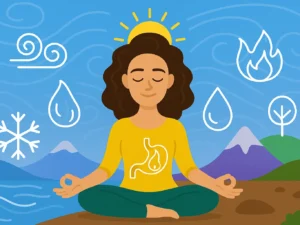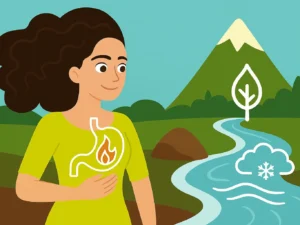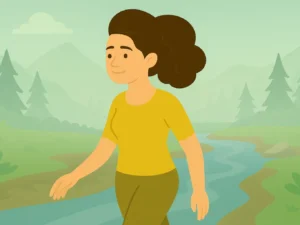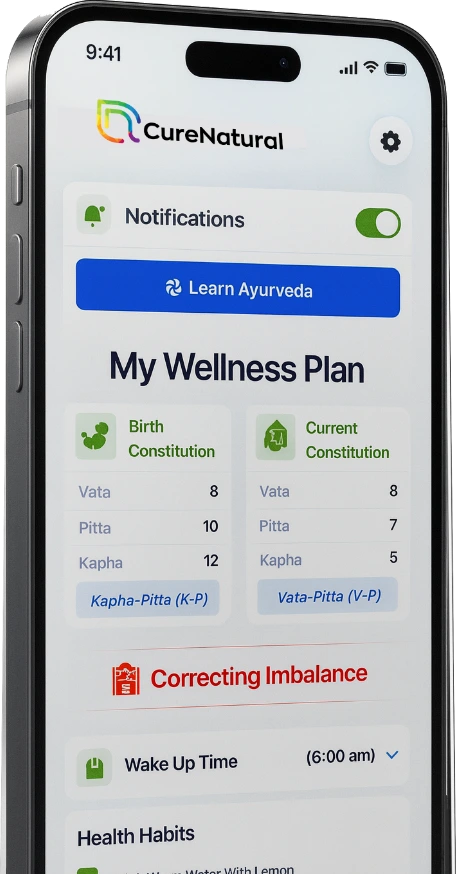Vata Dosha Management: Bringing Balance to Body, Mind & Energy
Do you live in constant motion — but feel drained instead of inspired?
Do your thoughts race faster than your body can rest?
Is your digestion unpredictable, your sleep light, and your focus scattered?
If so, your Vata Body Type — the dosha of air and movement — may be ruling your life instead of supporting it.
Vata Imbalance
A Vata imbalance can make you creative yet restless, visionary yet ungrounded, driven yet exhausted.
This course invites you to slow down, listen, and understand the elemental rhythm that governs your Vata Body Type, energy, mood, and health.
What You’ll Explore in This Course
1. Understanding the Nature of the Vata Body Constitution
You’ll begin by uncovering the essence of the Vata Constitution — how air and ether combine to shape your body, thoughts, and emotions.
You’ll learn to see imbalance not as a flaw but as a signal — the body’s language telling you it needs warmth, stability, and rhythm.
What does it mean to have too much air in your Vata Body Type?
- What are the physical features and mental tendencies of Vata?
Why do irregular routines scatter energy and weaken digestion?
How can stillness, moisture, and nourishment restore flow and focus for a Vata Constitution?
2. Lifestyle and the Roots of Vata Imbalance
The Vata Body Type thrives on movement — but too much motion leads to depletion.
You’ll explore how modern habits, e.g. skipping meals, multitasking, excessive screen time, irregular sleep, aggravate Vata. These habits mirror Vata’s own qualities of dryness, coldness, and irregularity.
The course shows how the smallest lifestyle changes, e.g. warm oil before bed, steady mealtimes, grounding rituals, can be beneficial for Vata Body Type.
3. The Rhythm of Nature and Daily Timing
Ayurveda teaches that balance is not only about what you do, but when you do it.
You’ll discover the Dosha Clock, which reveals how Vata, Pitta, and Kapha energies move through every 24-hour day.
By syncing your activities — sleep, meals, work, and rest — with nature’s rhythm, you begin to feel calm, alert, and effortlessly productive.
You’ll understand how the Vata Body Type governs early morning and afternoon times. And why aligning your schedule with this rhythm enhances both focus and relaxation.
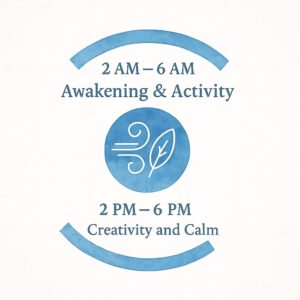
4. The Daily Vata Routine
From morning to night, every action becomes an opportunity for healing.
You’ll learn how warmth, oil, and regularity weave through sleep, bathing, eating, and self-care.
Each practice is designed to calm the nervous system and stabilize the Vata Constitution — turning ordinary moments into acts of balance.
5. Food as Therapy — The Vata Diet
Food is more than fuel; it’s vibration.
This module guides you through the art of choosing foods that calm the wind within.
You’ll learn the reasoning behind Ayurvedic food qualities — hot or cool, light or heavy, moist or dry — and how they directly affect digestion and energy for the Vata Body Type.
There is no need to memorize endless charts. Just intuitive understanding that empowers you to build a Vata Diet that feels warm, grounding, and nourishing.
6. Herbs, Dual-Dosha Diets, and Real-Life Application
You’ll see how Ayurvedic principles adapt when life becomes complex — when Vata Dosha mixes with Pitta or Kapha.
Through real-world scenarios, the course demonstrates how Ayurveda adjusts: which foods carry over, which are removed, and which are added as your constitution shifts.
This is Ayurveda in motion, flexible, intelligent, and personalized.
Why This Course Is Different
It’s not about restriction — it’s about alignment with your Vata Constitution.
It helps you sense your body’s messages before imbalance becomes illness.
It connects ancient wisdom with modern life — helping you design a personalized Vata Diet and lifestyle plan.
It bridges science and intuition — showing you the why behind every Ayurvedic recommendation for the Vata Constitution.
You’ll Walk Away With
A clear understanding of your Vata Body Type and its unique strengths and sensitivities.
Tools to restore warmth, rhythm, and steadiness to daily life.
Practical frameworks for managing the Vata Diet, lifestyle, herbs, and dual-dosha balance.
The confidence to create stability and creativity in harmony with your Vata Constitution.
Invitation
If your life feels like wind without direction, this course will help you find the ground beneath it.
Join our course to rediscover the balance between motion and stillness — to move through life not with anxiety, but with flow, purpose, and peace.
This course is part of the series of core body constitution management courses. The other body constitution management courses are Pitta Management and Kapha Management courses.



